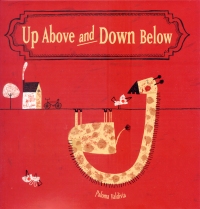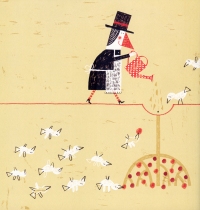| ________________
CM . . .
. Volume XIX Number 8. . . .October 26, 2012
excerpt:
Paloma Valdivia’s picture book addresses the topic of the different hemispheres and difference between people through the metaphor of those “up above” and those “down below.” The text simply and poetically explains concepts such as different seasons – “when spring makes its entrance in one place, fall pushes its way into the other.” It also addresses discrimination as it explains that, “On the top, they think the ones on the bottom are different” and vice-versa. The book uses language familiar to children’s literature about difference: it explains that all people are different, but “all the same.” The ending of the text disrupts this reductive rhetoric as it advocates that we all take the opportunity to “look at the world the other way around.” The suggestion of looking at the ways in which we are different, and attempting to see the perspective of the other, is a more productive way to think about difference than simply emphasising the ways in which we are “just like” one another. One of the messages seems to be that all people are very strange and different; characters have several heads, extravagant facial hair, wings, and mixtures of animal and human characteristics. While there is a pleasing variety of gendered expression, such as hairy men in two piece frilly bathing suits, there is a disappointing absence of racial difference. Given that it is a book about human variety, there are very few non-white characters. Valdivia is an experienced illustrator who uses her familiarity with the picture book form to experiment with the relationship of text and image, and with the physical form of the book. Her charming naïve illustrations concretize the idea of hemispherical difference by featuring a horizontal dividing line bisecting each page. The line has characters pictured right side up above it, and upside down below it. This arrangement creates an unusual distribution of weight on the page, especially so on the pages which only have illustrations on the top half or at the bottom half of the page. This pleasurable play of space and form is a strength of the book. Valdivia uses the dividing line to encourage the reader to explore the text in unusual ways. The last page and the back cover contain text which is actually upside down, and the final set of end papers are flipped, encouraging the reader to flip the book and read it again, upside down. Recommended. Lian Beveridge is a recent PhD graduate from the University of British Columbia. Her primary research interests are children’s literature and queer theory.
To comment
on this title or this review, send mail to cm@umanitoba.ca.
Copyright © the Manitoba Library Association. Reproduction for personal
use is permitted only if this copyright notice is maintained. Any
other reproduction is prohibited without permission.
NEXT REVIEW |
TABLE OF CONTENTS FOR THIS ISSUE
- October 26, 2012.
AUTHORS |
TITLES |
MEDIA REVIEWS |
PROFILES |
BACK ISSUES |
SEARCH |
CMARCHIVE |
HOME |

